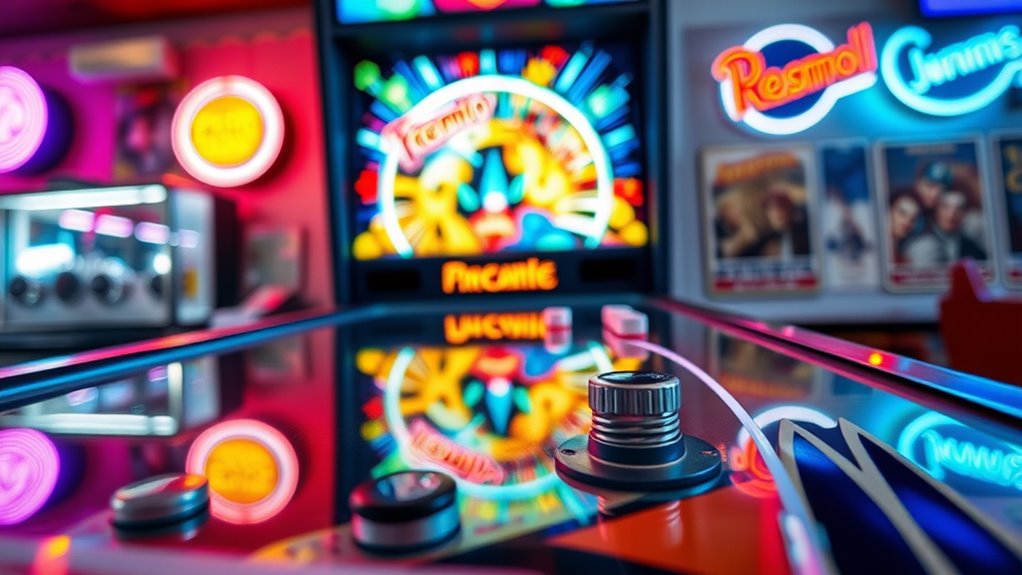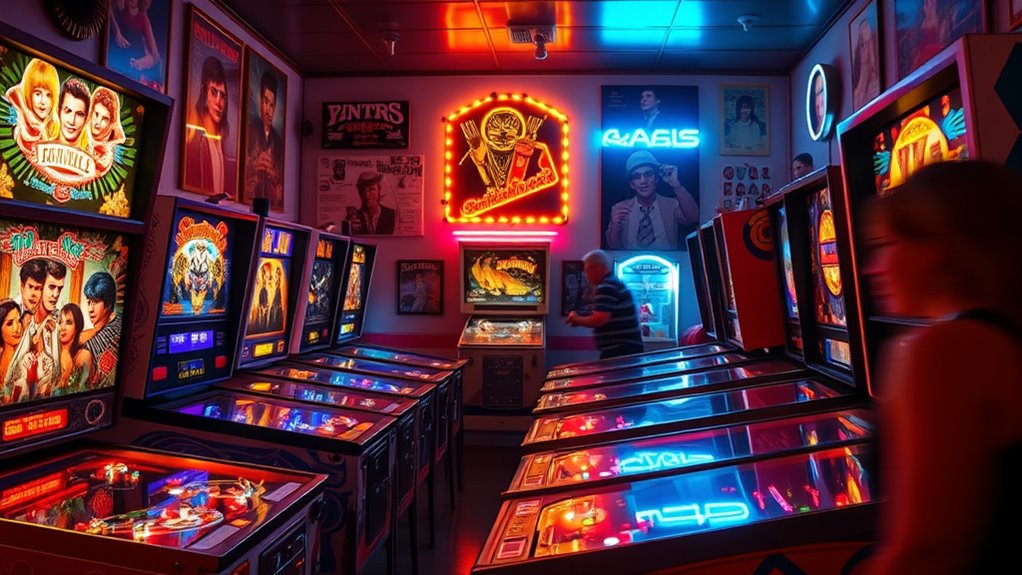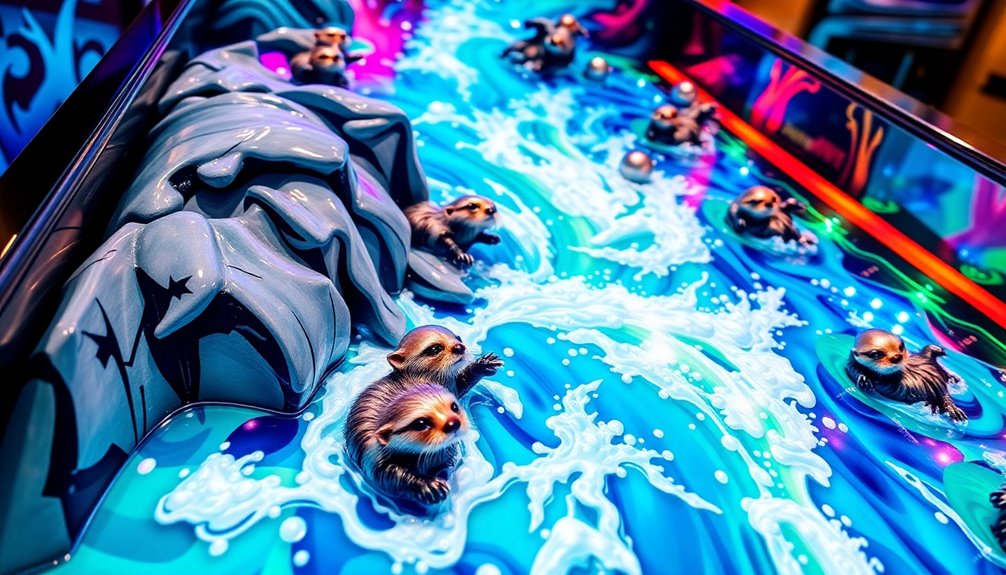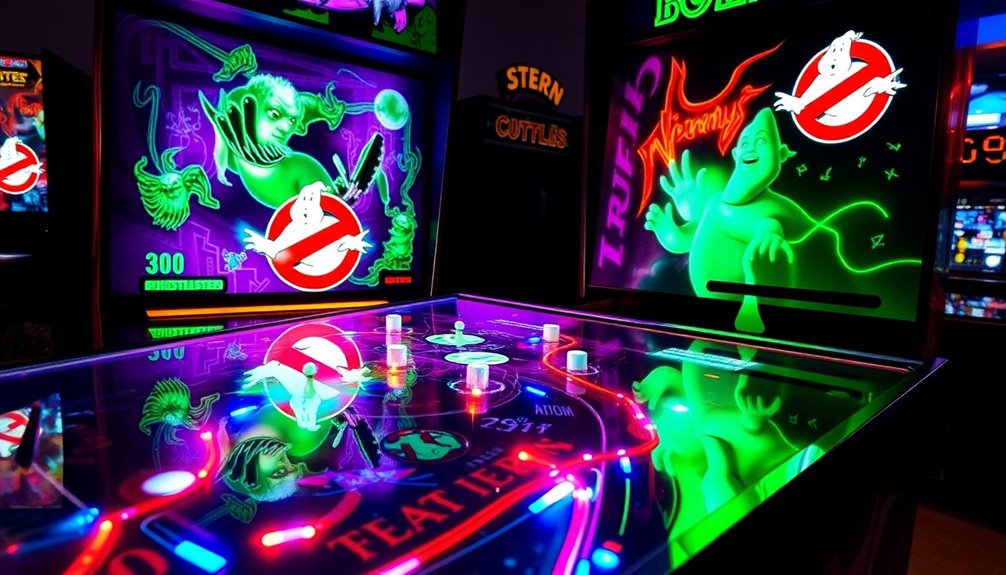Pinball has played a major role in shaping pop culture by symbolizing Americana, nostalgia, and rebellion. Its vibrant machines and dynamic gameplay have appeared in movies, music, and art, creating iconic images that resonate across generations. The tactile, immersive experience influenced game design and inspired artists worldwide. If you keep exploring, you’ll uncover how pinball‘s legacy continues to influence entertainment, technology, and cultural identity today.
Key Takeaways
- Pinball has become an iconic symbol of nostalgia and Americana, featured prominently in movies and media.
- Its colorful machines influenced visual aesthetics and inspired artists, musicians, and pop culture references.
- The physical gameplay mechanics introduced tactile engagement, shaping future interactive and skill-based gaming.
- Vintage and digital pinball recreations revived interest across generations, maintaining cultural relevance.
- Innovations in pinball design and technology contributed to immersive entertainment and sensory experiences in gaming.

Have you ever wondered how pinball machines became more than just arcade games? It’s a fascinating journey rooted in arcade nostalgia, a longing for the sights, sounds, and thrill of the golden age of arcades. When pinball first appeared in the early 20th century, it was simple—an electric version of bagatelle, a game that had been around for centuries. Over time, however, the game design evolution transformed pinball into a dynamic, immersive experience. Designers experimented with layouts, targets, flippers, and scoring mechanisms, turning pinball into an art form and a competitive sport. This constant innovation kept players captivated and helped embed pinball into the cultural fabric of the 20th century.
As pinball grew in popularity, it started to resonate beyond arcades, influencing features of pop culture like movies, music, and art. Think about the countless films that featured pinball machines as symbols of nostalgia, rebellion, or childhood innocence. The gleaming, colorful machines became iconic backdrops that evoked a sense of Americana. This visibility in media helped cement pinball’s place in popular consciousness, transforming it from a mere game to a cultural icon. Meanwhile, musicians and artists began referencing pinball in their work, celebrating its flashy aesthetics and frenetic energy. This cross-pollination of pop culture and pinball fueled a cycle of admiration and revival, especially as new generations discovered the game through vintage machines or digital recreations. Additionally, advances in technology, such as the development of high-refresh-rate projectors, have contributed to the modern reinterpretation and immersive presentation of pinball-themed entertainment.
The game’s influence extended into the domain of design and technology, inspiring innovations in user interfaces and game mechanics. The physicality of pinball—flippers, bumpers, and skill shots—offered a tactile experience that digital games couldn’t replicate at the time. This focus on physical interaction contributed to the game’s appeal and inspired future game design evolution, emphasizing user engagement and sensory feedback. As a result, pinball’s legacy persists in modern gaming, where concepts like skill-based play and immersive interfaces continue to draw from its pioneering spirit.
Frequently Asked Questions
How Did Pinball Influence Early Video Game Development?
You see, pinball influenced early video game development by introducing core mechanics like flipper controls and scoring systems, which became fundamental in arcade evolution. Developers mimicked pinball’s physics and gameplay, creating games that relied on skill and timing. This integration helped shape the design of early arcade games, blending mechanical pinball elements with digital technology, setting the foundation for more complex video game mechanics we see today.
Which Celebrities Are Known for Their Love of Pinball?
You might be surprised, but some stars truly adore pinball, turning their passion into a game of fame. Celebrities like Johnny Depp and Jack Nicholson are famous pinball collectors, turning their love into legendary endorsements. Their enthusiasm fuels the scene, making pinball a symbol of cool. These famous players keep the ball bouncing, proving pinball’s timeless appeal and inspiring fans to chase their own high scores.
Are There Famous Movies Centered Around Pinball Competitions?
Yes, there are famous movies centered around pinball competitions, like “The Pinball Circus” and “Tilt.” These films capture the excitement of pinball tournaments and the vibrant arcade scene. Watching them, you can see how pinball’s competitive spirit and cultural appeal have inspired filmmakers. These movies showcase the skill, strategy, and camaraderie found in pinball tournaments, highlighting its lasting influence within pop culture.
How Has Pinball Culture Impacted Modern Arcade Design?
You can see pinball culture shaping modern arcade design through its focus on arcade aesthetics and innovative game mechanics. Designers now incorporate vintage pinball elements, like bright lighting and tactile feedback, to create nostalgic yet fresh experiences. They also adapt pinball’s dynamic gameplay, emphasizing skill and quick reflexes, to modern game mechanics. This blend keeps arcades engaging, attracting both retro enthusiasts and new players alike.
What Role Did Pinball Play in 1980S Pop Music Videos?
You’ll notice pinball’s mesmerizing aesthetics and iconic soundtracks lighting up 1980s pop music videos, creating a sense of excitement and nostalgia. Its flashing lights and mechanical charm became symbols of youth rebellion and modernity. As you watch, you realize these videos cleverly used pinball imagery to evoke thrill and energy, embedding pinball’s essence into pop culture’s visual language, making it an unforgettable part of the decade’s musical identity.
Conclusion
You see, pinball’s playful presence persists in pop culture, proving that its pulse stays powerful and pervasive. From films to fandoms, its influence ignites imagination and inspires innovation. As you reflect on its reach, remember that pinball’s playful pulse continues to pervade our passions, proving that its legacy lasts long, lively, and legendary. In this way, pinball’s profound prominence proves it’s not just a game — it’s a pop culture phenomenon.








